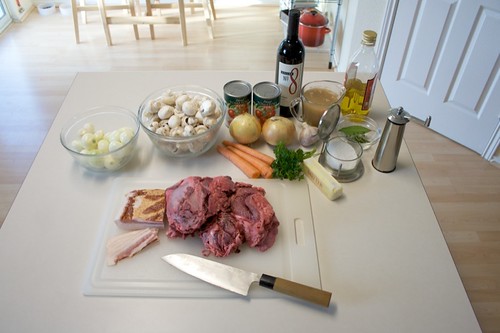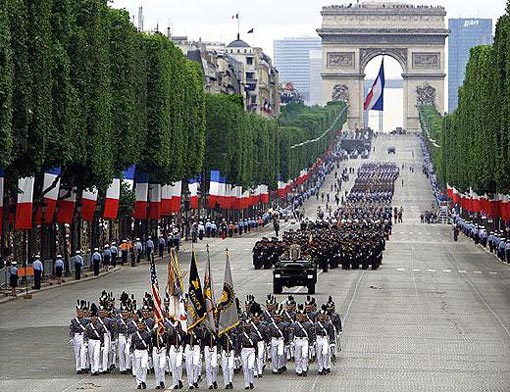Without the hype, beef bourguignon cooks down to what essentially is a type of beef stew or casserole. Albeit the very best beef stew or casserole you will ever eat.
Last spring, in Andrea’s cozy kitchen located in the Burgundy region of France, we enjoyed a beautiful lunch of this famous French dish. In truth it was almost a blip on the radar of the many wonderful meals we experienced. Almost. Upon my return to the states I set about trying to find a vintage copy of the cookbook we exclusively used. Yes, I am well aware that Mastering The Art of French Cooking (MTAOFC) is still in print and I could have had a copy on my doorstep the next day with one click of the Amazon button. But I am funny that way. I wanted a vintage copy in good condition to find me. I had to wait six months but there she was in all her Fleur~ de~ lis glory.

I spent an entire evening immersed in her pages. I found little clippings of recipes and articles from the previous owner along the way. You can’t get delights like that from a new book. I decided that the first recipe I would create would be the classic Beef Bourguignon (Boeuf à la Bourguignonne) found on page 315. (Unlike the masterful Julie Powell I have no lofty expectations that I will ever make every single recipe.) Of course MTAOFC is a grown up cookbook in that it has no photographs. Truthfully, grown up cookbooks such as this and her classic cousin, Joy of Cooking, make me nervous. But as many will tell you, if you can read, you can cook.
The preparation date was set for a Sunday when I would have hours to prepare the dish and a large table of visiting family members who would eat it. In my haste to begin I did not photograph a “before” photo of the ingredients. Thankfully another blogger had.

In the morning I began to sauté the pearl onions as indicated on page 483 (Oignons Glacés À Brun).
They then were braised in beef stock. (In the center is a bundle of herbs known as a bouquet garni .)
This portion of the recipe was then set aside.
I then began to sauté mushrooms in butter (Champignons Sautés Au Beurre) as found on page 513.
This portion of the recipe was also set aside.
I then simmered the bacon.
I had a bit of a crisis in that Mrs. Child’s indicated to sauté the bacon in a fireproof casserole dish. No doubt she means something along the lines of this:

I persevered with my common stainless steel pan and just drained and dried my simmered bacon and added a bit of oil to the pan and proceeded to sauté the bacon.
The bacon was then removed and then the stewing beef was added to the leftover bacon fat and browned on all sides.
The onion and carrots then had a turn. I do not use the tiny baby carrots that come in a bag as they are injected with dye and flavorless. I find all recipes taste better with the old fashioned long, peel it yourself, variety.
All the previous ingredients, and a few more, were then put into a glass casserole dish as that is what I had to work with. It said to cover the dish so I added a sheet of aluminum foil.
Four hours later I have to say that the dish didn’t look all that appetizing. But the glorious smell had men, children and beasts running to my front door for miles around. I transferred it into a pretty dish, and added the onions and mushrooms.
I served the dish with tiny Dutch gold potatoes, hot French bread and a simple field green salad. Dessert was an apple tart with fleur de sel caramel sauce. It was a hearty, rustic meal that was much appreciated by my family.
The next day I had it for lunch and Ooh La La it was even better. But truthfully, given the hour and a half of prep and four hours of cooking time I do not believe that this dish will become a staple in my household. I mastered it though and sometimes that is enough.
Bon Appétit!
Laura
































![IMG_7191[1] IMG_7191[1]](https://blogger.googleusercontent.com/img/b/R29vZ2xl/AVvXsEhsPHNuynpKfv8okR71TTBIyA6-n0f1fjL7CzavFfiP-cAWf5N6S9mh3SxrFGOMfiKorCVryhtrBCaCOXUjf755Yq4PK_zcX-zFkJ9UP_xkNE9SUhNwu_OHmvs40GNDjrSShJ8YrSbcjQ/?imgmax=800)




































